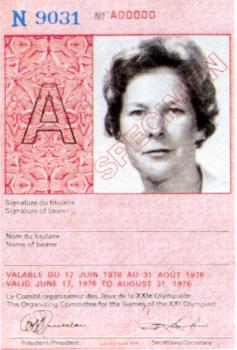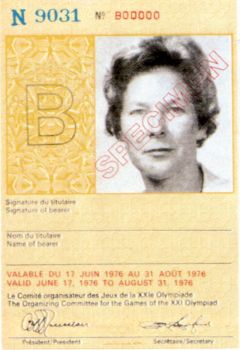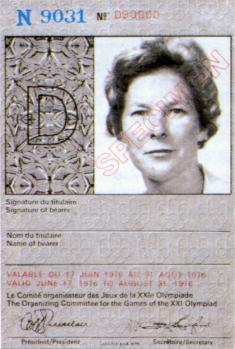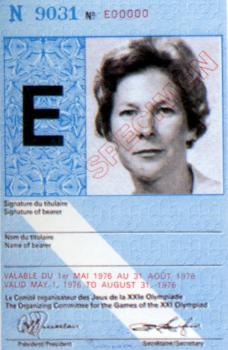Identity Card
Rules and Regulations IOC rules contain stringent requirements covering the sections of the grandstands reserved for the Olympic family, so its members had to be clearly and positively identified. In Montréal, there were three major categories: 1. Olympic family. 2. Personnel. 3. Security. 1. Cards for the Olympic family were filled in by COJO or sent blank to Olympic organizations. In the latter case, they served as Olympic passports, except for the press. Once accepted by the Ministry of Manpower and Immigration, these cards were in effect official documents permitting entry into Canada for the Olympic Games. They were validated upon arrival in Montréal once the bearer's identity was verified. 2. Cards for personnel were always filled out and issued by COJO. 3. Security cards were completed and issued by Security. Accreditation of the Olympic Family Approximately one-third of those provided with official identification,
(29,554 people) were part of the Olympic family, and, like all cards issued,
theirs were printed on watermarked paper similar to that used for bank
notes.
Validation Generally speaking, validation was the same for all members of the Olympic family. The holder first presented his card at the validation centre. After checking their lists, security agents verified the holder's identity and stamped the card with a validation seal. One of the three flaps was detached and kept for reference, while the other two were folded, coded, sealed with two eyelets in a plastic envelope, and the whole unit returned to the holder. In case of errors, erasures, or unsuitable photographs, the card was redone in an identical manner. To facilitate this operation, each COJO directorate responsible for
a category of the Olympic family assigned employees to the different validation
centres. And Accreditation sent along someone to solve special problems.
Validation centres were located in the Queen Elizabeth Hotel, the Olympic
Equestrian Centre at Bromont, the Olympic Yachting Centre in Kingston,
the Olympic Village, the main press centre, the Sheraton-Mount Royal Hotel,
and the International Youth Camp. (Source Document: Official Report 1976,
Vol. I, page 532 ) |



